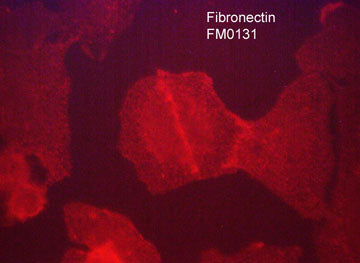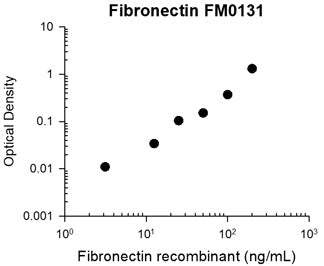Anti-Fibronectin (Cell/Heparin2 Binding region) Antibody
- 产品详情
- 实验流程
- 背景知识
Application
| WB, ICC, IP |
|---|---|
| Primary Accession | P02751 |
| Host | Mouse |
| Clonality | Mouse Monoclonal |
| Isotype | IgG1 |
| Clone Names | M013 |
| Calculated MW | 272320 Da |
| Gene ID | 2335 |
|---|---|
| Other Names | FN, Cold-insoluble globulin, CIG, Anastellin, Ugl-Y1, Ugl-Y2, Ugl-Y3, FN1 |
| Target/Specificity | In the extracellular matrix, fibronectin provides essential connections to cells through interaction with integrins and other receptors that regulate cell adhesion, migration, and differentiation. Fibronectin is secreted as a large dimeric glycoprotein with subunits that range in size from 230 kDa to 270 kDa. Fibronectin is composed of three different types of modules termed type I, II, and III repeats, as well as two fibrin binding and two heparin binding domains, a collagen interaction region and cell attachment domain. The diverse set of binding domains provides fibronectin with the ability to interact simultaneously with other fibronectin molecules, other ECM components (e.g., collagens and proteoglycans), cell surface receptors, and extracellular enzymes. Plasma fibronectin (soluble dimeric form) is secreted by hepatocytes, while cellular fibronectin (dimeric or cross-linked multimeric forms), made by fibroblasts, epithelial and other cell types, is deposited as fibrils in the extracellular matrix. Fibronectin fibrilogenesis has important functions during tissue development, and during pathological progression of tissues and wound healing. |
| Dilution | WB~~1:1000 ICC~~N/A IP~~N/A |
| Storage | Maintain refrigerated at 2-8°C for up to 6 months. For long term storage store at -20°C in small aliquots to prevent freeze-thaw cycles. |
| Precautions | Anti-Fibronectin (Cell/Heparin2 Binding region) Antibody is for research use only and not for use in diagnostic or therapeutic procedures. |
| Shipping | Blue Ice |
For Research Use Only. Not For Use In Diagnostic Procedures.
Provided below are standard protocols that you may find useful for product applications.
BACKGROUND
In the extracellular matrix, fibronectin provides essential connections to cells through interaction with integrins and other receptors that regulate cell adhesion, migration, and differentiation. Fibronectin is secreted as a large dimeric glycoprotein with subunits that range in size from 230 kDa to 270 kDa. Fibronectin is composed of three different types of modules termed type I, II, and III repeats, as well as two fibrin binding and two heparin binding domains, a collagen interaction region and cell attachment domain. The diverse set of binding domains provides fibronectin with the ability to interact simultaneously with other fibronectin molecules, other ECM components (e.g., collagens and proteoglycans), cell surface receptors, and extracellular enzymes. Plasma fibronectin (soluble dimeric form) is secreted by hepatocytes, while cellular fibronectin (dimeric or cross-linked multimeric forms), made by fibroblasts, epithelial and other cell types, is deposited as fibrils in the extracellular matrix. Fibronectin fibrilogenesis has important functions during tissue development, and during pathological progression of tissues and wound healing.
终于等到您。ABCEPTA(百远生物)抗体产品。
点击下方“我要评价 ”按钮提交您的反馈信息,您的反馈和评价是我们最宝贵的财富之一,
我们将在1-3个工作日内处理您的反馈信息。
如有疑问,联系:0512-88856768 tech-china@abcepta.com.























 癌症的基本特征包括细胞增殖、血管生成、迁移、凋亡逃避机制和细胞永生等。找到癌症发生过程中这些通路的关键标记物和对应的抗体用于检测至关重要。
癌症的基本特征包括细胞增殖、血管生成、迁移、凋亡逃避机制和细胞永生等。找到癌症发生过程中这些通路的关键标记物和对应的抗体用于检测至关重要。 为您推荐一个泛素化位点预测神器——泛素化分析工具,可以为您的蛋白的泛素化位点作出预测和评分。
为您推荐一个泛素化位点预测神器——泛素化分析工具,可以为您的蛋白的泛素化位点作出预测和评分。 细胞自噬受体图形绘图工具为你的蛋白的细胞受体结合位点作出预测和评分,识别结合到自噬通路中的蛋白是非常重要的,便于让我们理解自噬在正常生理、病理过程中的作用,如发育、细胞分化、神经退化性疾病、压力条件下、感染和癌症。
细胞自噬受体图形绘图工具为你的蛋白的细胞受体结合位点作出预测和评分,识别结合到自噬通路中的蛋白是非常重要的,便于让我们理解自噬在正常生理、病理过程中的作用,如发育、细胞分化、神经退化性疾病、压力条件下、感染和癌症。








